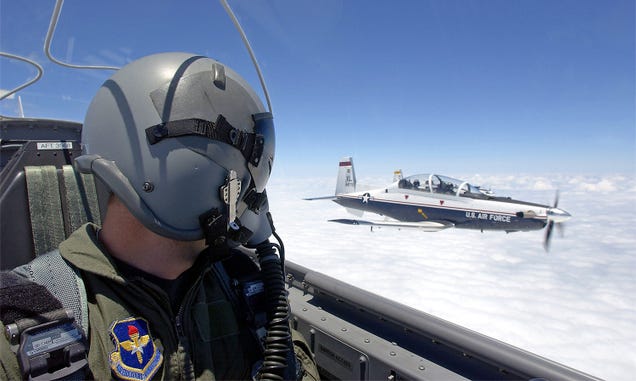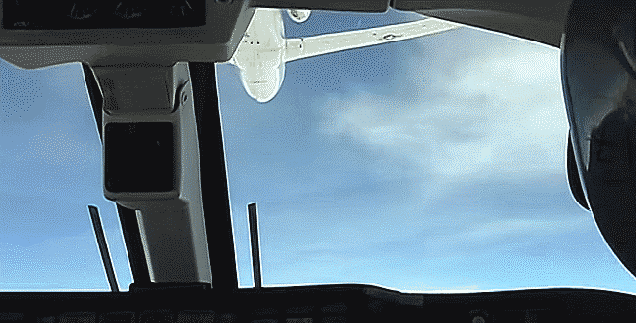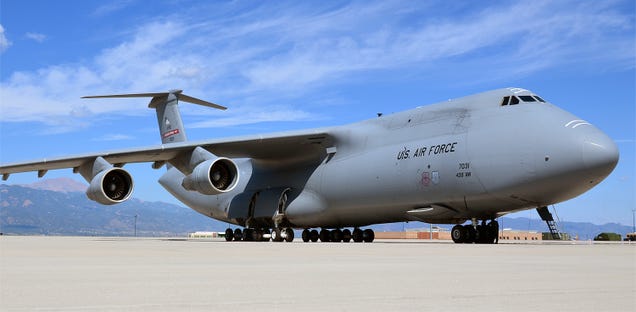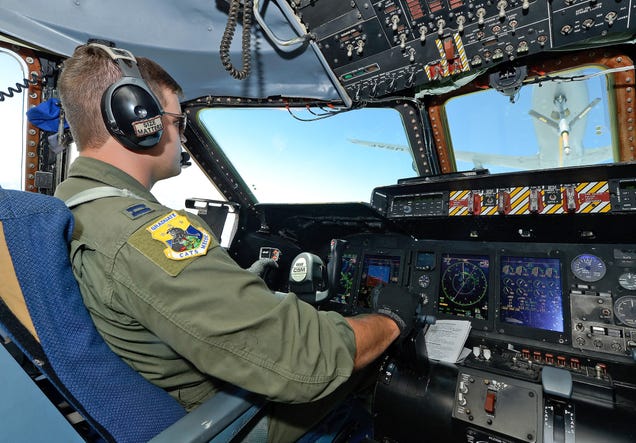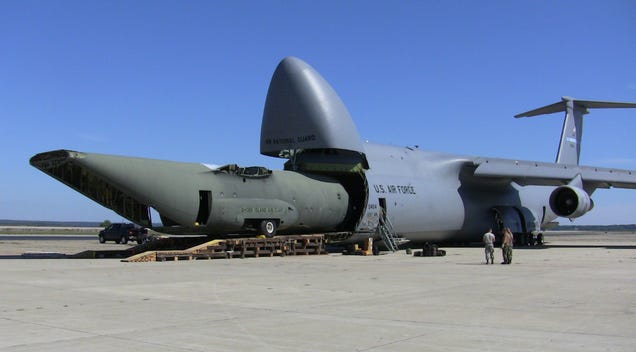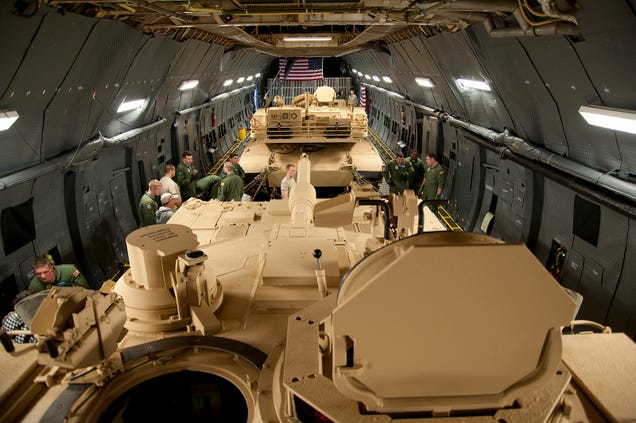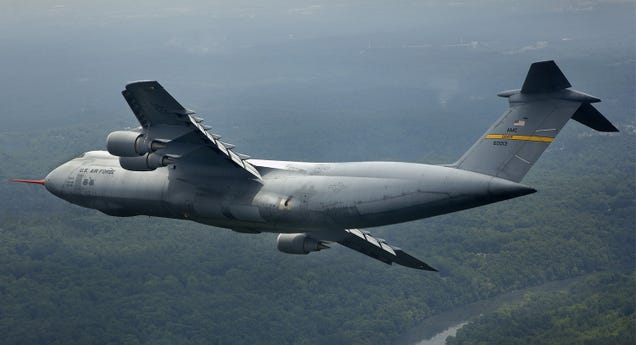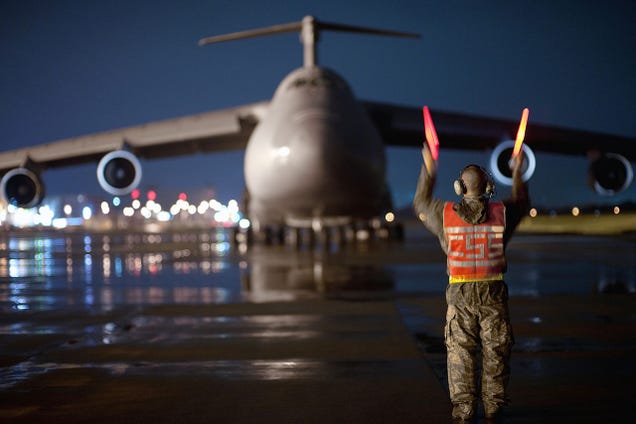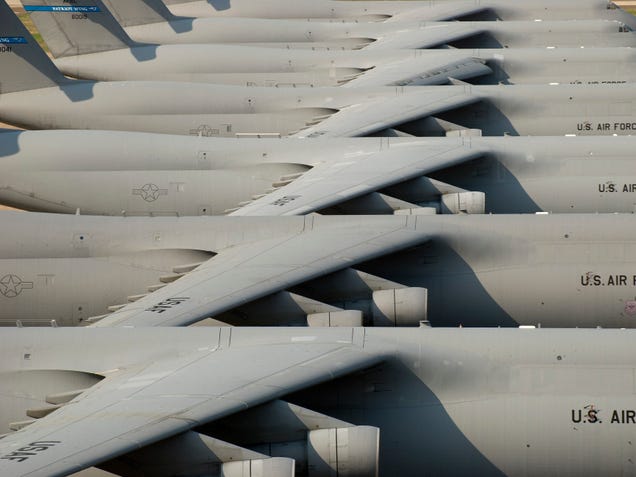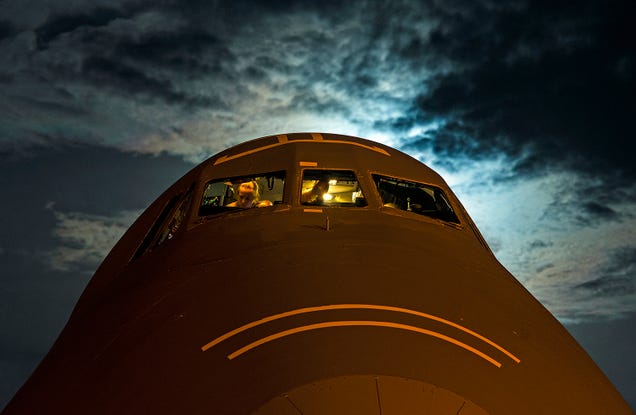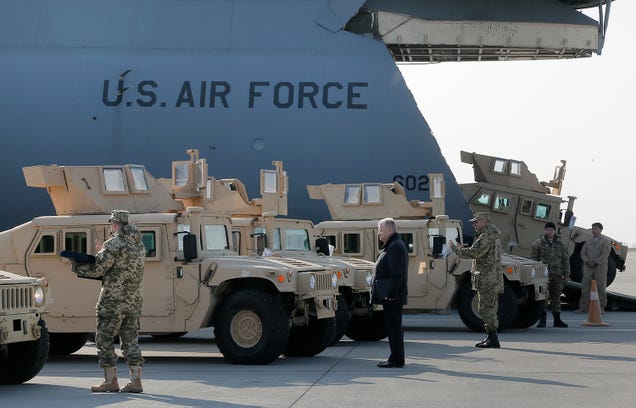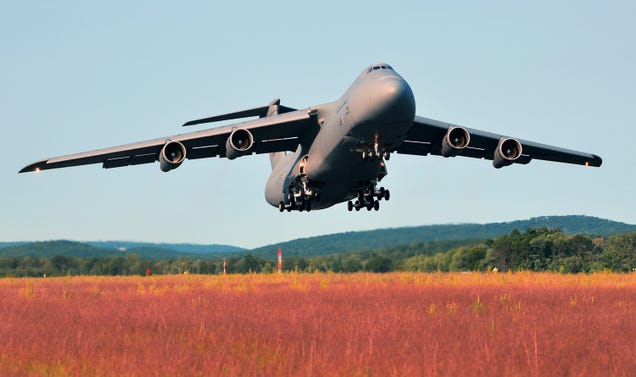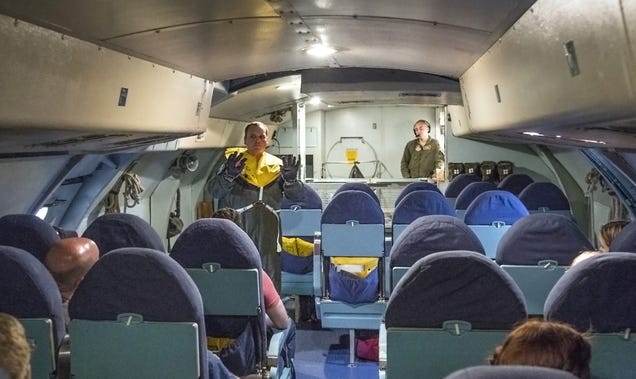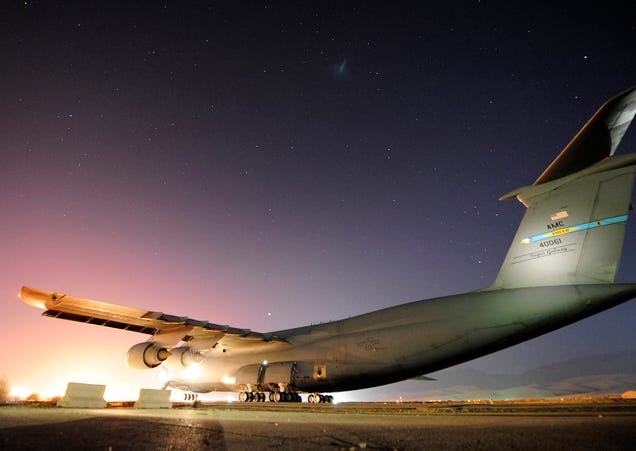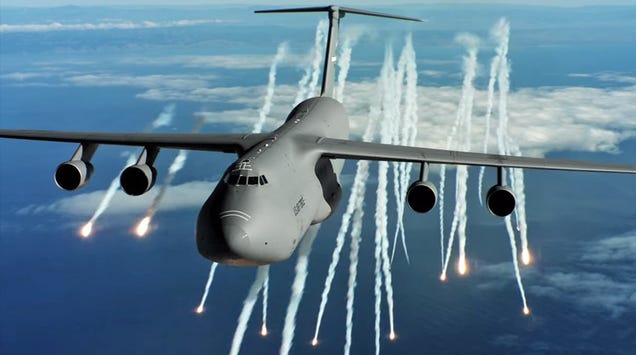
I know how it is to fly Space A (available) on them... plan on having cool IFE (in flight emergency) experiences, and long layovers at unanticipated airfields as they break and wait for parts. Passenger seating is palletized airline seats on the top floor of the interior, facing rearwards, with no windows.
So during said IFEs you can sit and imagine what bad things are happening outside the aircraft.
Though it did get me a 5 day layover in Anchorage at Elmendorf AFB. In November. In the snow. I got to see a moose! And Anchorage has an awesome craft brewery culture growing.
One of Foxtrot Alpha’s readers, Ben Brown, flies the Pentagon’s biggest jet, the mighty Lockheed C-5 Galaxy. He has taken the time to give us a detailed view of not only what it takes to become a C-5 pilot, but what it is like being part of the complex logistical ballet that allows the C-5 to move massive cargo all over globe.
What brought you into aviation and eventually the USAF?
“I wanted to join the Air Force and become a pilot from the age of three. Both of my grandfathers and my father were all in the Air Force. I spent the first few years of my life at the Air Force Academy experiencing all of the flyovers and the Thunderbirds.
One of my grandfathers was a pilot so that inspired me to fly, and I kept the goal of going to the Academy and flying in mind throughout high school. My parents also made sure I had every opportunity to succeed and achieve my goals.”
Was jumping into a T-6 Texan II for the first time thrilling?
“About half my class from the Academy got pilot slots, some that started two months after graduation to over a year for those who got selected to go get their master’s degree. We found out our jobs in the Fall of our senior year, and our start dates the following Spring. My start date was 10 months after graduation so I stayed at the Academy as an assistant in my graduating department and during that time attended the Initial Flight Screening (IFS) program in Pueblo.
Initial Flight Screening is an introduction to Air Force flying in the tiny Diamond DA-20 and the basic ideas and expectations such as the boldface operations procedures. After passing that course, I moved to Laughlin AFB in Del Rio, Texas to fly the T-6 Texan II. The T-6 is like nothing I had flown prior or since, and it’s a blast to fly. First flight I had no idea what was going on, but the Instructor Pilot (IP) demonstrated what the aircraft could do and made for a pretty awesome ride.
Pilot training is a lot of IP demonstrating and the student continuously attempting to perfect the maneuvers, from stalls to touch and goes and further building onto that with barrel rolls, cloverleafs, and a whole assortment of acrobatics.
I had a good time in the T-6 program, quickly getting used to putting in right rudder and learning how to strap into the ejection seat. I would say my favorite block of T-6 training was formation. It was challenging to plan a sortie to stay in the imaginary military operations area (MOA) and accomplish all required acrobatics and maneuvers, and then switch from lead to wing and do it again, but the formation solo where it was just me doing all of that was exhilarating. One of the nice things about Laughlin is that to get back home, all you have to do is keep the Rio Grande to your south.
Coming out of T-6s, I had my pick of T-38s for the fighter/bomber track and T-1s for the airlift tanker track. Before I even got to pilot training I knew I wanted to go heavies as those provided the best base and lifestyle options to be stationed close to my wife (she’s a space operator who at the time was launching rockets out of Cape Canaveral). The acrobatics and formations were fun, but not enough to sway me away from the heavy aircraft the lifestyle and the culture in general, so I selected the T-1 to go heavies.”
Many people don’t even know the T-1 is a major training platform for the USAF, how does the converted biz jet prepare you for an aircraft like the C-5 Galaxy?
“The T-1 (Beechcraft 400/Mitsubishi 300) is a small white business jet that the Air Force uses to train pilots that are going to fly cargo, air refueling or other wide body and commercial derivative aircraft.
On several out-and-backs (a training flight where one student would fly for about two hours, full stop at an airport, the crew would plan for the second half and get some food, and then a second student would fly the next two hours and return to Laughlin), we’d park next to civilian Beech 400s and wander over to look inside them while their pilots came over to look at ours. Ours had everything except the jump seat removed from the back and a large radio cabinet installed for the UHF and TACAN radio equipment, whereas theirs had a bunch of seats.
It was an interesting airplane to fly after the T-6. You couldn’t jerk it around the sky, but it was faster and had longer legs than the T-6 so we could go anywhere in Texas to practice. It had the added benefit of not worrying about strapping into an ejection seat or wearing a G-suit, and it had a tiny bathroom. The first part of the training was the basics of how to fly it, stalls and turns in the military operating area (MOA) and lots of touch-and-goes at a variety of airports across Texas, learning all about takeoffs and landings and the various speeds that dictate what controls the airplane and when.
The second block of T-1 training is the main meat and potatoes portion; it was all about instrument flight rules (IFR). As a student you’d plan a sortie to go to San Angelo, shoot a bunch of instrument approaches, and then maybe go over to Midland and do the same thing. This was all to get practice with all sorts of instrument approaches while also studying all the IFR publications on the ground to learn about the types of airspaces and the rules that govern them.
Then there was the check ride at the end of the section that was the most heavily weighted for overall pilot class ranking. It’s a pretty vital section; it establishes a good foundation for a larger aircraft flying overseas and how to obey instrument flight rules.
The final block of T-1 training was to prepare pilots for aerial refueling and airdrop. For aerial refueling, two jets would meet in a MOA or a refueling track near Fort Stockton and maneuver to get one aircraft behind the other and then get up into the pre-contact-contact positions. This position has one jet flying within a few feet of the other behind and below for a minute or so.
For airdrop, two jets would fly formation through a low level route and practice the timing and procedures required to get to a target and slow down and simulate an airdrop. These were exciting, as some of our local low-levels went through the mountains near Big Bend National Park, and the “airdrop” target was the only tree for 50 miles in that part of Texas.
In all, training had some fun times, but it was a lot of repetition to get the IFR basics down, which can be monotonous. It was rumored that the T-1 had its flight controls modified to more closely resemble the roll rates of the heavy aircraft that the Air Force flies. It certainly felt like flying a heavy in a small plane.
As T-1 training wrapped up, each of the three undergraduate pilot training (UPT) bases gets a list of all the aircraft potentially available to classes that are about to finish, about 25 or so airplanes, and each student has to rank the airframe they want. Each student is then given a rank based upon all the scores from each flight, check rides and academics, as well as some other points, which get crunched through a math formula and ranks each student. There are conference calls between the three UPT bases to then use those rankings and assign an aircraft to each student.
For example, there may be only one C-130 to Ramstein AFB in the drop at Columbus and a C-5 to Dover at Laughlin AFB, and the number one student pilot at Laughlin wants the C-130 to Ramstein.
The bases make trades and the best assignments are made for the individual and the needs of the Air Force. A week or so after the leadership decides on the assignments we have a “drop” night where they reveal to the students which plane and location they are going to next. It’s an exciting and tense time, and the C-5 is one of those aircraft that there are only a couple of each year, so I was quite happy to get a C-5 in the drop.”
What is it like jumping from a small business jet to the largest aircraft in America’s inventory?
“I knew the C-5 was big, but I had no clue how big it was until I saw it at the airshow at Fairchild AFB while I was in SERE school. It is massive. There were hundreds of people sitting under the wings for shade with plenty of room to spare.
Once I got to Dover AFB I got introduced to it a lot better. The cockpit is enormous, with a huge center console, with two throttle quadrants and it sits over 30 feet above the ground. The cargo box feels roomy, especially with the new lighting that the “M” model has. I didn’t know about the separate passenger compartment in the back, or that the unpressurized airspace between the rear pressure door and the outer cargo doors is larger than the cargo space of a C-130.
My training consisted of three months of classes and full-motion sims that focused on the basics of flying the airplane, processing emergency procedures, Category Two Instrument Landing System approaches and oceanic procedures. It was a lot of information that built upon everything I’d learned in T-1s in UPT. As for how the airplane flew, it felt exactly like the T-1 for roll rates, but it has a ton more power available. The takeoff and landing data (TOLD) calculations are similar to the T-1 with relatively low rotation speeds on takeoff.
Honestly, the hardest thing to do in the C-5 is taxiing. With its wide body and large wingspan it’s challenging. You can see the wing tips from the cockpit, but you can’t determine exactly where they are, so you have to utilize clock positions on the outboard engines to figure out where the wingtip is and how far away from an obstacle it is and whether or not you can safely taxi past it.
The nose wheel is 16 feet behind the pilot’s seating position, so sometimes in order to execute a turn the pilots are hanging out over the grass before the turn begins. The aft main gear caster, so if turning left you turn the tiller to turn the nose left, caster the gear, and they will swing to the right to allow for a tighter turn, and then hydraulic pressure forces them back to center when you center the switch.
A main concern before a mission is making sure that the taxiways and parking ramps are wide enough and can support our weight. If they plan to park us in a location where we would have to backup, we have to make sure that they have the C-5 tow bar, a giant tuning fork that connects to the outside of our nose gear and few locations have it. As for the flying, once on the runway and pushing throttles up, it’s not that hard. The C-5M climbs surprisingly fast for how big it is; I’ve seen climb rates greater than 7000 feet per minute.
Typically, we takeoff and get the autopilot and auto throttles engaged and fly our flight plan, getting all the radios and equipment ready for oceanic airspace entry, then click off the automation while on final approach and about to land. I’ve heard that refueling behind a KC-10 can be interesting due to the center engine on the KC-10 blowing right onto the giant T-tail of the C-5, but I am yet to see an aerial refueling. Aerial refueling is another excellent capability of the C-5M, it’s very rarely required because the new engines are a lot more powerful and efficient.
The C-5’s tall tail can make crosswind landings interesting, but we train for that a lot and the gear is quite robust. There are some situations that we train for in the sim where flying can get challenging, but a majority of those emergency situations have never happened in any model of the C-5.
For the first year or so in the jet, a C-5 pilot is expected to master the general knowledge of the systems and rules regulating the airplane as well as gain flying experience of the C-5. Once a pilot becomes an aircraft commander, they are expected to master the FAA and ICAO rules that govern operations, as well as how to lead a mission. Aircraft commanders make sure each location we go to is ready and able to handle the C-5M.
They ensure the cargo and passengers are ready to be on/offloaded, and most importantly the crew is taken care of. All these areas together ensure we are abiding by the Air Force rules and ready to execute the mission.”
What can the C-5 do that other USAF heavies cannot?
“In short, the C-5 can carry the most cargo the furthest. Its max weight is 840,000 pounds. It can carry the most cargo of any US airlifter. Last fall, as part of a retrograde operation to bring cargo and equipment out of Afghanistan, each C-5 was setting record payloads, with the heaviest being 280,880 pounds. Overall 25.5 million pounds of cargo and 447 passengers were moved on 152 missions.
One C-5 mission can take the place of up to five C-17 missions, depending on what the cargo is. It can carry 100,000 pounds of cargo 5,000 miles without refueling, for example, from Dover to Turkey, or from Germany to Alaska. It has twice the pallet positions of the C-17, 36 to 18, and supposedly due to the gear configuration and weight distribution, has a lighter footprint at above the max weight compared to a C-17. The C-5 typically cruises at .77 Mach, the C-17 at .74 and with the C-5M’s new engines it’s quieter.
The C-5 can carry outsize cargo from pallets to vehicles that would not fit in any other jet. In addition to cargo, we can always carry passengers in the troop compartment above the cargo compartment in airline-like seats. This makes it easier to carry equipment and their operators. For example, we bring home Marine helicopters with the maintenance crew.
It can carry two M1 Abrams main battle tanks if required, or six Apaches. The “C” models are modified for space lift support and carry satellites; a loadmaster has proudly shown me pictures of the loading and moving of a section of the James Webb space telescope in a specialized huge climate controlled box.
To facilitate loading, the C-5 can kneel. This is where all the wheel bogies are on hydraulic lifts and it can kneel the nose down, tail down, or evenly so that the belly is only inches from the ground. Kneeling makes the loading of aircraft and vehicles a lot easier than a C-17 and provides drive in and off capability without the needing to back out.
The C-5 is also a massive demonstration of the coordination required to do any mission. There will be multiple pilots, engineers, loadmasters and crew chiefs on every mission. The pilots primarily maneuver the airplane.
The engineers are key, they know the ins and outs of every system on the plane and how to make it work best. They control the fuel balancing, the pressurization, cooling and the expansive high pressure hydraulic systems. They also calculate the takeoff and landing data for the pilots. They are super smart and I could not do their job.
The loadmasters are masters of their craft, knowing how to build a load onto a jet in the most efficient and safe manner, along with complexities like if there are multiple destinations for the cargo and how to arrange it so that it can be unloaded efficiently.
They regularly have to use trigonometry to create nests of chains to distribute the weight of strange shaped or super heavy cargo so that it won’t move in any axis in flight. They figure out how the airplane needs to be configured to load and unload best, does it just need to stay as is, or level kneel so that the bottom of the jet is only inches from the ground, or forward kneel to create a smoother ramp surface to unload rolling stock.
The crew chiefs are flying representatives of our ground maintenance and the airplanes are their babies. They know how to fix any of our problems and how to interface with the local maintenance to get the jet fixed and back on the road in a timely manner.
Along with all the aircrew, the C-5 relies on all the various types of ground crews, from the airmen that empty the latrines to the ones that refill the liquid oxygen and nitrogen systems and who replace our tires, to the ones in base ops that file flight plans and provide weather and knowledge about the locations we’ll be going.
It’s a complex undertaking to get a C-5 mission on the road and it takes the teamwork of many personnel in order to ensure that the mission occurs successfully. Overall, our support is awesome.”
The C-5 is a massive, complex and aging aircraft, does it live up to its reputation for abysmal reliability?
“The C-5 was designed in the 1960s and there are still some flying from the original production line. It was designed in the days when it was thought the best course of action for wings was to make them as stiff as possible. It contains many levels of redundancy and backups to ensure that everything will continue to work even if a system or two malfunctions.
It has gone through various upgrades, replacing some of the analog systems with digital systems. And yes, it’s big, so there are a lot of systems and things that can go wrong and break. But with the modernization of the fleet to the C-5M configuration and the greater spread of digital systems throughout the plane to analyze and record data, the reliability has been steadily increasing and has already surpassed the reliability rate promised to the tax payers and congress when the “M” upgrade was proposed.
Not all the C-5s are “M” models yet though, so there are still older “B” models in the system. There are only a few C-5 bases in the US and thus most of the expertise is within the continental United States, whereas going overseas, a lot of the maintenance and parts are concentrated at key locations, like Ramstein in Germany.
As such, if a C-5 lands in Spain with an issue that the local maintenance can’t fix, the specialized maintenance and parts have to be brought over from Ramstein to fix the plane. In other words, the expertise and parts are far and few between. Due to it being an older airplane though, all things that can get broken have been broken, so there is a solution and knowledge on how to repair everything that could happen to “Freddy.”
Authors note: FRED is a nickname for the C-5 used in a sarcastic and loving way by its crews and maintainers. FRED, of “Freddy” as it is lovingly called, stands for Fucking Ridiculous Economic (or) Environmental Disaster.
Each upgrade has seen continuous improvements in all systems installed on the airplane. There are miles of wiring onboard, primary and backup and emergency systems, hydraulic systems with hundreds of gallons of fluid operating at 3000 psi, hundreds of thousands of pounds of fuel in tanks flowing through the airplane and it’s all a mixture of analog and digital systems trying to talk and interface with each other to make sure things work or to describe the problem to its operators if they don’t. Each plane has it gremlins and reputation for oddities, but for the most part, they all work very well. The C-5 reliability is only getting better.”
What are the differences between the C-5A, B, C, and M?
“The C-5A was the original model. It had the classic engines that generated that sky ripping sound. It operated in Vietnam (I just saw a talk from the aircraft commander that flew Operation Babylift in a C-5, and he was an excellent speaker and did an amazing job in flying an airplane that had everything going wrong).
The “B” is an upgraded “A,” as best I know, it was the second generation of the C-5 from the 1980s production line and the majority of the airframes flying now were originally B models. They received an avionics upgrade, a boost to the digital age, with the AMP program that gave the C-5 multi-function displays and a glass cockpit. There are two C-5Cs that are in all essence B models, except that the troop compartment over the rear of the cargo compartment has been removed to allow it to move huge space related cargo.
The “M” is the latest upgrade iteration, taking the “B” models (and one “A”) and re-engining them with CF-6 turbofan engines, upgrading related systems to the engine and upgrading the cargo compartment with much brighter lighting systems and paneling. It now has approximately 20 percent greater thrust and a 50 percent faster climb rate while decreasing takeoff distance 30 percent with a big overall increase in fuel efficiency.
The main point of the upgrade was the engines. The C-5M has more thrust available on three engines than the “B” had on all four. The new engines allow the plane to fly heavier cargo loads farther (about 90,000 pounds more), by allowing it to climb higher and faster and operating much more efficiently than models with the previous engines.
Getting new engines also allows for more air generation in the plane, so it can climb higher yet retain pressurization. The new engines are very quiet, living under the pattern at Dover, you can barely hear a C-5. I’ve had a takeoff in a C-5M that took less than 1500 feet and occurred at 90 knots, which I was quite surprised with.
The Air Force actually asked for the same percentage of reverse thrust on the new engines as the old engines were capable of, about 30 percent, and a few months after the reengining Lockheed came back and told the Air Force that the new engines actually delivered 60 percent reverse thrust, so that’s pretty nice. Overall, the “M” is a more powerful and efficient airplane in the exact same package as all the rest.”
How does the C-5 compare to the Russian An-124 Condor and why doesn’t the US just outsource its outsized cargo transport needs?
“The An-124 is a big bird as well, but the C-5 has its advantages. The C-5 is made in America, flown by an Air Force crew, and a display of American airpower wherever it goes.
The C-5 can refuel in flight, if required. Inflight, the whole of the C-5 is pressurized, whereas an An-124 (to my knowledge) only pressurizes the flight deck and passenger compartment, so the cargo compartment is unpressurized and can’t easily be checked in flight.
The biggest strength in my mind is that the C-5 has an easily configurable floor; it can be flat and smooth for rolling stock, or you can flip portions around and pop up rails so that you can roll pallets on, as well as having omni-directional rollers on the cargo loading ramps.
I’ve heard that the An-124 has a wooden floor, so that makes it different than ours. I’m not familiar with all the particulars of the An-124, so I don’t know how fast or far it goes, or if it can taxi easily, or anything like that. Bottom line, from my perspective, is both are massive aircraft with unique capabilities.”
What is a typical C-5 “road trip” like?
“Typically we get told a few days before a mission what the mission is and where it’s going. The aircraft commander will overview everything and will call to the various locations to gather more information, such as parking spot details and expected taxi routing.
The other pilots might get tasked with researching the various fields that the mission is planned to go to, to make sure they are suitable for a C-5 and to try and spot trouble areas. The loadmasters contact the load teams at those locations to find out what sort of equipment is available to load/unload with, what the cargo load is and how it’s packed and then they develop their loading plan.
The day of the mission, everyone shows up, briefs, loads up and gets going. Typically we fly first to a US location to pick up a cargo before taking it overseas. From the moment you show up for the mission to when it ends the airplane and crew is under the control of Tanker Airlift Control Center (TACC) at Scott AFB, and they dictate where the mission is going, what the cargo is and the timing.
For every day and leg of the mission there is a set timeline for getting to a location, unloading/loading and refueling, and continuing on and all this timing and other metrics are reported back to TACC.
Some missions are short, just dropping cargo off and coming back in a couple days, some are a week or more before returning home because they bounce around the system dropping cargo and passengers off all over the world. During flight, if I’m not one of the pilots flying, I’m in the back sleeping or eating typically and that’s true for the engineers as well, whereas the loadmasters cycle through working with the passengers and ensuring that they are rested for the cargo movements at the next location.
The crew chiefs are available to troubleshoot issues in flight and be our representative to the local maintenance crews upon landing. As you can imagine, combat missions take a lot more planning and vigilance to carry out. The C-5 can, but doesn’t, go into austere locations. It’s the biggest airplane in the inventory, carrying a lot of cargo and fuel, so it’s usually sent to only a few combat locations that are determined to be suitable.”
What could the C-5 and its community use that it currently does not have?
“The fleet is on its way to being fully upgraded to the “M.” Dover was completed a couple of years ago and Travis will soon have its full complement of “M” models. Then the reserve bases, Kelly and Westover, will begin receiving their upgrades.
We have an electronic flight bag; each aircrew member has an iPad that contains the hundreds of publications, instructions and manuals about the plane and its capabilities and the laws that govern air travel and so much more. The pilots use the iPads to display the charts and instrument approaches, departures, and airfield diagrams and the engineers and load masters use their iPads for their governing regulations and pubs in relation to their job and the running of the airplane.
The iPad has reduced the copious amount of paper regulations that was previously carried, which is great. Currently there’s no permanent mounting system for the iPads for the pilots or engineer, or a way to charge it while it’s in the cockpit, so that’d be a nice improvement.
Perhaps we could use an upgraded radar to get a better view of the weather around us, or an upgrade to the communication package (example, for commercial satcomm, we use AERO-I and I believe the airlines are already on the next level of AERO) so that we could have modern data capability to, say, update our iPads or use an app for weather rather than texting the request in and hoping it works.
The interior emergency lighting systems consists of rectangular wall mounted lights that can be removed and used like a flashlight, but those have never been upgraded, and take 16 hours to charge for an optimal 45 minutes of light with a lightbulb that’d be at home on a string of Christmas lights, so upgrading all the lighting on the jet to LEDs like the cargo compartment would be welcome also.
We just had an operating system upgrade that fixed a lot of the quirks and gremlins that were being produced by the computer systems and their interfaces, so that has been a welcome upgrade.”
What is the C-5 Galaxy community’s culture like?
“The C-5 community, at least at Dover, is really relaxed and supportive. At home base everyone works to make sure they are ready for the mission and that the missions on the road are supported as best as possible.
Everyone supports each other and works together really well, from flying to intramurals at home. There are regular potlucks where all the families are welcome. Once we get on the road, the crew works hard making sure the mission gets going, stays moving and is safe and efficient.
Depending on the length of the day on the mission, a bunch of crew members may go out and get dinner (or breakfast or lunch, depends on the time zone) and there are certain locations, like the “Greasy Spoon” in Rota, Spain where it seems like it’s tradition for the whole crew to get food at upon landing and before heading to lodging.
There’s a big emphasis on food in a C-5 crew, making sure there’s a Shoppette or commissary stop for everyone to stock up for the crew rest period and the next leg of the mission ahead. Overall, it’s not a combative or competitive culture; it’s a cooperative culture that fosters good relationships, hard work, and accomplishing the mission.”
What is the best time you have had operating the aircraft so far?
“Getting the mission done is a great time. It always feels great to get home with another mission under your belt. I am fortunate that the only time I’ve had an airplane break on a mission was transitioning through Travis AFB and I was able to see a large amount of my family that I hadn’t seen in a few years. That mission also had the neat little time trick of crossing the dateline going east and seeing the same sunset and the same dawn twice.
Coming in for landing in Waikiki, or cruising over Cape Cod, or the great frozen tundra of northern Canada, following the green fields of the Nile to the Mediterranean, there have been some beautiful sights. I was on the crew of the first C-5M into Nuremberg in support of Operation Atlantic Resolve, and the Germans were ecstatic to have us there and it’s always neat to be wooed over.
Being able to cook up a steak and veggies, or cookies, or anything 6 hours into a 12-hour flight and eat that while at the controls of a giant airplane at 36,000 feet makes for quite an enjoyable experience.
Carrying presidential limos and support vehicles along with Secret Service in support of a presidential mission was really interesting. Everyone has some cool missions stories; one of the missions into Ukraine in the Spring delivered Humvees and was met with great fanfare by the Ukrainian president who gave a speech and energetically drove a Humvee off the jet.
My first mission, or “Dollar Ride,” I wanted to watch the cargo get loaded downrange. The load was two Marine CH-53s, huge helicopters that fit with only an inch or two to spare in the vertical once they are loaded. It happened to be a particularly long upload, as they winched it up, the front and rear gear supports would have to be pressurized or depressurized to make the helicopter as even as possible as it went up the ramp, and then the second helicopter was loaded the same way but in reverse of the previous.
What was supposed to be a normal load time turned into a seven hour load and during loading the stairway up to the crew compartment is closed. As a result, I was stuck downstairs for the entire time and was unprepared to do so.
Additionally, I am mostly useless to help with the load because there were several experienced loadmasters and a Marine load crew there to ensure that it is loaded correctly. Since then I’ve helped with easier unloads, like pushing pallets or putting away chains, but the loadmasters are the best at their jobs so it’s mostly better if the pilots stay out of the way and let the loadmasters make it happen.
Share with us ten things that we probably don’t know about the C-5 Galaxy?
1.) “We can use our inboard engine thrust reversers to descend and slowdown in flight, which is great to have at heavy weights with the massive amount of momentum we have.
2.) The rear gear swing free in turns when we caster them, whereas the forward mains stay in place, and the nose gear leads the turn. The majority of the weight is on the main gear and not the nose gear, so sometimes it doesn’t want to turn at all.
3.) The engines are de-tuned from their max thrust that they are built for because the wings couldn’t handle it all, but it’s still a ton of thrust.
4.) A C-5 once airdropped and launched an ICBM, and the airplane that did it is at the AMC Museum at Dover Air Force Base, along with a model of the missile.
5.) The C-5 cockpit is so wide that there are two throttle quadrants, both pilots can reach the flap handle, but only the copilot in the right seat can reach the gear handle.
6.) There are two bunk rooms with three bunks apiece in the crew compartment, several sections of seats, a bathroom and a kitchen with fridge and oven. I would contend that the loadmasters on C-5s are some of the best cooks in the Air Force, at least among aircrew, utilizing all three ovens on the plane to whip up a Thanksgiving dinner or cookies or a roast pork loin with potatoes. I have sampled some awesome food that they’ve made in flight.
7.) The only way to the flight deck is through the stairs in the cargo compartment and the only way to the troop compartment for passengers is through the rear stairs, there’s a whole compartment of environmental and hydraulic components separating them. Along with the normal stairs, there’s a rope ladder, inflatable slide, and descent reels (pretty much zip lines) to get out of the crew deck.
8.) You can climb all the way to the top of the tail, but only on the ground because that section is unpressurized during flight. The total unpressurized area between the rear pressure door and the outer cargo doors is greater in area than the cargo area of a C-130.
9.) The smallest flap section is the size of a Volkswagen Beetle and the biggest is about the size of a C-130 wing.
10.) The majority of C-5Ms are upgraded “B” models, but there is one upgraded “A” model, so it went straight from “A” to “M” and thus has some oddities about it. These include the engineers station not getting all the digital display upgrades the “Bs” received and it has an additional firefighting system that was removed in the “Bs,” along with some other quirks.”
A huge thank you to our C-5 pilot Lt. Ben Brown and Lt. Sarah Bergstein from the 436th Airlift Wing’s Public Affairs Office as well as all the hard working people at Dover AFB who fly and maintain these massive and complex machines.
Photo credits: C-5 and An-124- U.S. Air Force photo by Maj. Marc Hernandez, C-5M test flight- U.S. Air Force uncredited, C-130 inside C-5- U.S. Air Force 109th Airlift Wing uncredited, T-6 aerial photo U.S. Air Force photo by Tech. Sgt. Jeffrey Allen, C-6 on apron- U.S Air Force uncredited, C-5 Cockpit at night- U.S. Air Force photo by Staff Sgt. Jeremy Bowcock, C-5 loading CH-53E- RAAF Facebook page, C-5 in depot- U.S. Air Force photo/SSgt. Kelly Goonan, T-1 Jayhawk- U.S. Air Force photo uncredited, C-5 sky and lit cockpit- U.S. Air Force photo by Senior Airman Dennis Sloan, C-5 marshalling at night- U.S. Air Force photo by Osakabe Yasuo, C-5 Takeoff over flower field- U.S. Air Force photo uncredited, Air Force Academy Graduation- Mike Kaplan, U.S. Air Force, Upper passenger deck- U.S. Air Force photo Lt. Col. Robert Couse-Baker, C-5 refueling- U.S. Air Force photo by Greg L. Davis, C-5 carrying tanks- U.S. Air Force photo by Lt. Col. Chad E. Gibson, Humvees in Ukraine- AP.
(Tyler Rogoway - Foxtrot Alpha)

